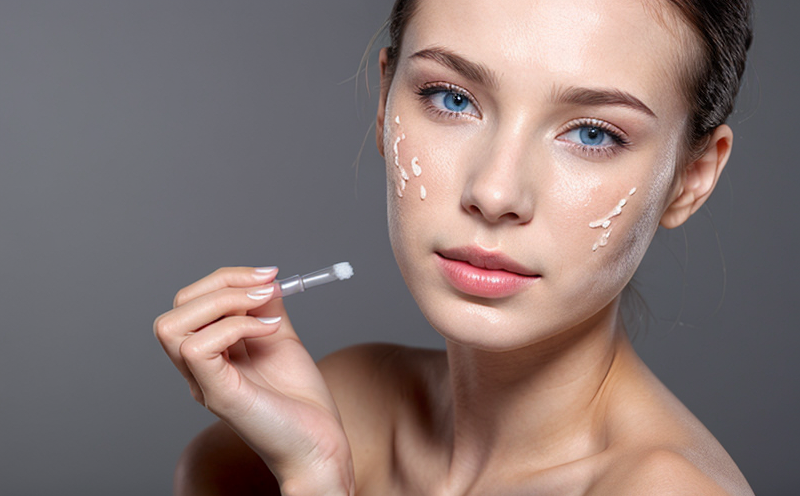Irritation Testing of Cosmetic Contact Lens Solutions
Understanding the potential irritancy and sensitization of cosmetic contact lens solutions is critical in ensuring product safety. In this service, we provide comprehensive irritation testing to evaluate how these solutions interact with the ocular surface. This testing ensures that products meet stringent regulatory requirements and are safe for consumer use.
The ocular surface is highly sensitive, and even minor irritations can lead to discomfort or more severe issues like inflammation. Irritation testing helps identify any potential adverse effects early in the development process, allowing manufacturers to make necessary adjustments before product launch. This service employs internationally recognized standards such as ISO 10993-10:2009 for biological evaluation of medical devices and ISO 10993-18:2017 for biocompatibility testing.
The testing process involves exposing the contact lens solution to human corneal epithelial cells or in some cases, using animal models. The results are then analyzed based on specific criteria such as cell viability, cytotoxicity, and inflammatory response. This approach ensures that the test data is both reproducible and reliable.
Our team of experts uses advanced laboratory equipment to conduct these tests with precision and accuracy. We ensure that all specimens are prepared in accordance with the specified protocols, maintaining strict quality control measures throughout the process. The results provide a clear picture of the solution's potential for causing irritation or sensitization, allowing manufacturers to make informed decisions about product formulation.
This service is particularly valuable for cosmetic companies developing new contact lens solutions or reformulating existing products. It helps them stay compliant with regulatory standards and maintain their brand reputation by ensuring product safety. By partnering with us, they can streamline the development process and reduce the risk of recalls or legal challenges.
Our comprehensive approach to irritation testing ensures that companies not only meet but exceed expectations for product safety. This service is just one part of our broader commitment to providing high-quality testing solutions tailored to the unique needs of each client in the cosmetics sector.
Applied Standards
- ISO 10993-10:2009 - Biological Evaluation of Medical Devices Part 10: Ocular Irritation and Corrosivity Testing
- ISO 10993-18:2017 - Biocompatibility - Determination of the Cytotoxicity of Medical Devices Using Primary Cell Cultures (In Vitro Method)
We strictly adhere to these standards, ensuring that our testing procedures are both accurate and reproducible. This alignment with international guidelines enhances the credibility of our test results and ensures compliance with regulatory requirements.
Scope and Methodology
The scope of this service encompasses a range of tests designed to assess the potential for ocular irritation caused by cosmetic contact lens solutions. These tests are conducted using human corneal epithelial cells or, in some cases, animal models. The methodology involves exposing the solution to these specimens under controlled conditions and monitoring various parameters over time.
Key parameters measured include cell viability, cytotoxicity, and inflammatory response. Cell viability is assessed through staining techniques that allow for accurate quantification of live cells versus dead ones. Cytotoxicity is evaluated by measuring the release of lactate dehydrogenase (LDH) as an indicator of cellular damage. Inflammatory response is monitored using markers such as TNF-alpha, IL-6, and IL-1beta.
The testing process involves several steps: specimen preparation, exposure to the solution, incubation period, and post-exposure assessment. Specimens are prepared according to strict protocols to ensure consistency across tests. Exposure durations vary depending on the specific requirements of each client but typically range from 24 hours up to a week.
Post-exposure assessments are conducted using advanced microscopy techniques to observe any changes in cell morphology and viability. This allows for detailed analysis of the effects of the solution on the ocular surface. The results are then compiled into comprehensive reports, providing clients with a clear understanding of their product's potential for causing irritation or sensitization.
Competitive Advantage and Market Impact
- Comprehensive testing aligns with the latest regulatory requirements.
- Use of advanced laboratory equipment ensures precision and accuracy.
- Strict adherence to international standards enhances test credibility.
- Early identification of potential issues allows for timely product adjustments.
- Comprehensive reports provide clear insights into product safety.
Our service provides a significant competitive advantage by ensuring that clients stay ahead of regulatory changes and industry trends. By identifying potential issues early in the development process, companies can avoid costly delays or recalls. This proactive approach also enhances brand reputation and customer trust, contributing to long-term market success.





